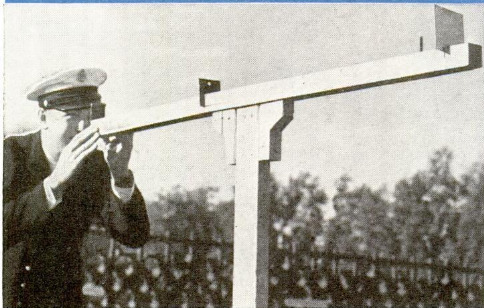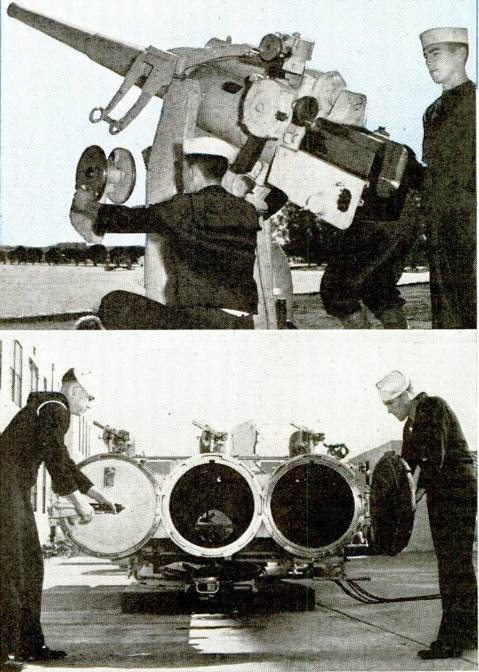IF YOU are pointing a big gun on one of America’s fighting ships, you must be “on and steady on” when you turn the elevating wheel to match the needle of the fire control dial. Your turret gets a miss instead of a hit if you err by a fraction of an inch. When you are depressing an antiaircraft pom-pom to knock down an oncoming torpedo plane, the barest hesitation may give your enemy time to drop his “fish” and sink your ship. Accuracy and speed are two things that win a battle and this applies to men as well as to battleships or airplanes. No matter what his job, every man in Uncle Sam’s Navy is on his toes these days. To help keep him so the Navy has developed an athletic program of sports and exercises that keeps him in trim all the time he is afloat. “Physical fitness is a prerequisite to mental alertness,” says Lieut. Comdr. Gene Tunney, former world champion fighter and now director of the navy’s physical training program. “Through the physical education activities at the training stations, sound bodies are toughened like that of a boxer preparing for a fight. Our men are learning to live like professional warriors.”The toughening program starts on the day a young recruit enters a training station. Land-lubbers need special instruction before they can be useful on board ship, so new sailors go to school before they go to sea. A modern battleship is so large and complex below deck, for instance, that a green hand can easily become lost. He has to learn how to train a gun and how to handle himself in a small boat, how to sling his hammock and how to take care of marine machinery before he can call himself a sailor. America is fighting on two oceans today and our double navy is being expanded as fast as more ships can be produced. Thousands of new sailors are needed to man these ships, hence training facilities are being expanded and naval instruction is being speeded up. From the time he hears the bosun’s pipe at two bells in the morning watch until he falls into bed at night, the recruit’s day is packed with classes and lectures. He has to absorb as much knowledge as he can. Yet time is still found for plenty of athletics. That, plus regular meals and regular hours, makes him gain an average of nine pounds in weight by the time he is ready for sea duty. Uniforms that were baggy when first issued to him now fit perfectly. Amateur boxers who had been light-weights before they entered the service discover that they have moved up to the welterweight class. At the Naval TrainingStation in San Diego a typical day in the life of a young sailor begins with half an hour of setting-up exercises and double-time drill before the 6:15 breakfast call. After chow he falls in for infantry maneuvers and the manual of arms, gas lectures and first aid instruction, and talks on seamanship. There are more lectures and drills after the noon-day meal and the school day ordinarily ends at three o'clock. However, in times like these the recruit is likely to attend lectures on a few nights each week. To become a good fighting sailor he must have plenty of competitive spirit and competition is fostered all through the course in practical seamanship. At the loading machine that represents a gun and at which he learns his duties as part of a gun crew he does more than simply go through the motions. Each crew competes against the other crews in the company for speed and accuracy. The physical drills become recreation and sport instead of drudgery. Lining up to learn how to scale the side of a ship with the aid of a cargo net, each crew gets away with a rush at the instructor’s cry of “Hit that net, sailors, and hit it hard!” The instructor’s stopwatch decides which crew took the least time to get over the rail. Mooring an imaginary ship with the aid of heaving lines and 8-inch hawsers is a dry-land exercise that teaches the real thing and the crews go to work with a ready tug-of-war will. While still at the station the recruits learn how to handle themselves on masts and booms. They climb Jacob’s ladders to an overhead boom, make their way acrossit,and descend by means of another ladder at the end. Funny stories have been told for generations about men who spent their lives at sea yet never learned to swim a stroke. This doesn’t apply to American sailors. Swimming instruction for those who cannot swim starts during their first week. Other parts of the physical program include bayonet drills and mass boxing instruction, During the training period the recruit is inoculated against lockjaw, yellow fever, and several other conditions. His food is the special concern of a staff of doctors and dieticians who prepare balanced menus, oversee the cooking, and who make daily inspections of the kitchens to insure the utmost cleanliness. Feeding the thousands of recruits at the station promptly and without delay requires good timing. The sailors line up cafeteria style for chow after their company name has been called on the loud speaker system. The sport facilities at the San Diego Naval Training station include a 9-hole golf course with a larger one projected, a large gymnasium and swimming pool, an outdoor boxing arena, and a boat landing. There are eight double and eight single handball courts, 16 tennis courts, eight basketball courts, five softball diamonds, one master baseball diamond and several batting cages, as well as volleyball, badminton, and table and paddle tennis equipment. In addition there is a track and field layout. Many of the courts are lighted for night playing. An average of 100 recruits a day find time for a game of golf and participation in the other sports is on a corresponding scale. Lieut. George O'Brien, athletics officer, and his staff of instructors, including Lee Ramage, former well known boxer, have worked out a sports program in which every recruit may participate. Teams representing different companies compete in the major sports. Athletics are still part of the recruit’s life after he has finished training and joined the fleet. In the cramped spaces of a ship, where ordinary facilities for sports are lacking, brisk exercises help maintain the high physical condition of the men. Special setting up exercises have been devised by Tunney and his staff of experts. Ordinarily, one room below deck is used as a gymnasium and is stocked with equipment that the sailors use during their time off. Boxing, running, and other contests are held between teams chosen from each watch. Field sports are practiced ashore when ships are in port and each ship has football, basketball, baseball, and other teams that compete for fleet championships. These days, of course, formal athletic competition is practically at a standstill, though athletics are still as much a part of daily life afloat as the exigencies of war will permit. Not every young sailor can become an athletic champion, but athletics is doing its part to help our navy win the championship of the world.




